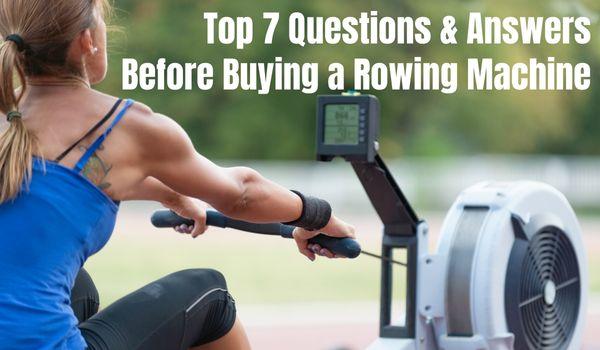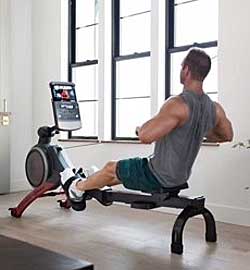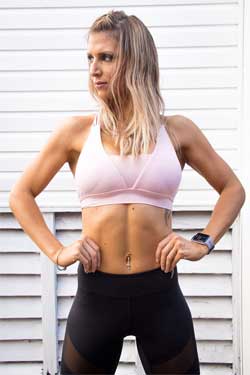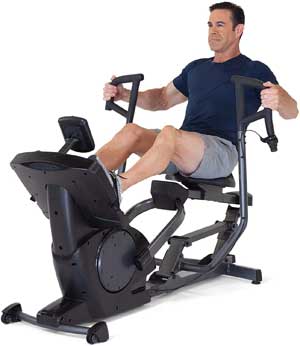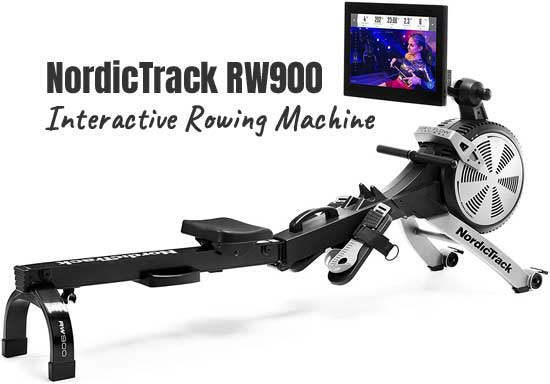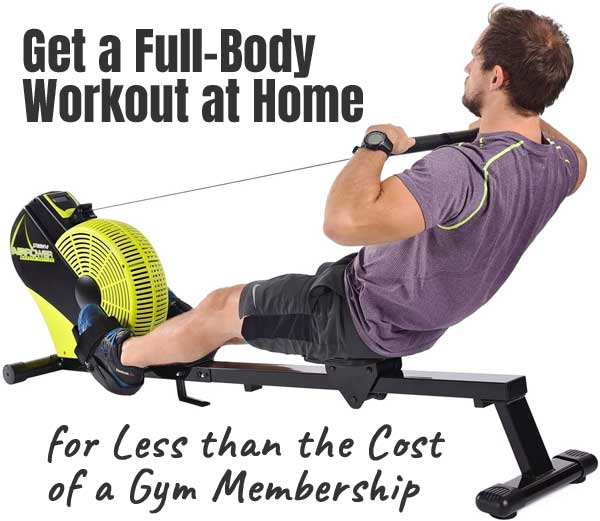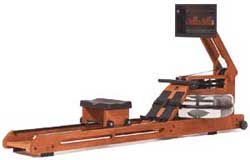Do you want to buy a rowing machine? Here are answers to common questions, plus information that will you help you find the best indoor rower for you.
1. What are the Benefits of Rowing Machines?
Rowing machines offer multiple health benefits. Plus, they have several advantages over other home exercises equipment like treadmills, stationary bikes or elliptical machines.
- Get a Full Body Workout: As you push and pull on the rower, you engage multiple muscle groups simultaneously, including the arms, legs, back and core. As a result, you can get a full-body workout is less time.
- Cardio Training: Rowing is an aerobic exercise that increases your heart rate. In addition, you can perform high intensity (HIIT) workouts on these machines. Rowing machines are good for cardio.
- Build Strength & Endurance: Higher intensity sessions help you build muscle strength through resistance, while longer workouts grow your endurance capabilities.
- Low-Impact Exercise: Compared to sports that involve running or jumping, rowing is very low impact. Consequently, it can be ideal for people who suffer with joint pain, mobility or who simply want to avoid high impact exercise.
- Convenient and Versatile: Many indoor rowers can fold and roll, so you can easily move or carry them from one place to another. In addition, several models don’t require electricity. Therefore, you don’t need a power outlet nearby, and you can conveniently use them outdoors.
- Stress Relief: As with any form of exercise, rowing can be a great stress reliever, even when used for short stints. Need to blow off some steam? Go for a 5-minute sprint or 8 minute TABATA.
- Calorie-Burning: Rowing is very effective at burning calories because it works both your upper and lower body at the same time. In addition, as you grow your muscles, you increase your metabolic rate when at rest, thus burning more calories throughout the day.
2. Do Rowing Machines Help with Weight Loss?
1. First of all, rowing burns more calories while you exercise. The increased movement and breathing helps you release fat.
2. Second, as you grow your muscles, you increase your metabolic rate when at rest, thus burning more calories while at rest (even while you sleep).
3. Third, the stress-relieving feature helps many people develop better eating habits because they stop “stress eating”.
4. Fourth, the glucose disposal that comes with exercise keeps blood glucose levels lower. As a result people become more metabolically healthy and lower their appetite.
3. How Many Calories Do You Burn on an Indoor Rower?
Calories burned during rowing depends on workout intensity, body weight, fitness level and workout duration. That said, here are some rough numbers to go by.
A 150 lb person person weighing 150 lbs can burn about 240-295 calories in 30 minutes of moderate-intensity rowing. A person weighing 185 lbs can burn approximately 295-355 calories in the same amount of time.
Rowing isn’t just about exercise; it revs up your metabolism too. This means you’ll torch extra calories long after your workout, like a fire that keeps burning logs even after it’s been stoked. For instance, imagine rowing vigorously for 30 minutes in the morning.
Afterward, your body continues to burn calories throughout the day, helping you stay energized and active. So, rowing not only works your muscles but also helps you burn more calories, making your entire day more active and vibrant.
4. What Muscles Does Indoor Rowing Work?
An indoor rowing machine works several muscle groups. The only area that gets neglected is the chest, so throw in a few push-ups during or after your rowing session if you want. Alternatively, the Teeter Power 10 has push-and-pull handlebars, so you can incorporate the pushing movement right into your workout.
- Quads (front of the thighs)
- Hamstrings (back of the thighs)
- Glutes (buttocks)
- Calves (lower legs)
- Back muscles (lats, traps and rhomboids)
- Core muscles (abs and obliques)
- Arm muscles (biceps and forearms)
5. What to Look for in a Home Rowing Machine?
Are you shopping for an indoor rower? Here are some factors to consider as you compare machines.
1. Resistance System: 2 popular rower styles offer magnetic or air resistance. They also give you a smooth and quiet rowing experience. On the other hand, if you prefer the swooshing sound of water, look at water rowers.
2. Comfort: Some machines come with cushioned seats (or you can purchase rowing seat pads separately). No-slip handles and adjustable footrests are other comfort features to look for.
3. Display: Displays vary by machine, and you typically get more with higher end models. For example, many mid-range rowers come with larger displays that have pre-programmed workouts and multiple tracking options. Interactive rowers, like the NordicTrack RW900 Smart Rower, have all of the tracking features and programmed workouts plus an extra-large touch screen, bluetooth, training system similar to that of Peloton.
4. Storage: Some rowers can fold in half. Other models have wheels on the bottom – or can be stored upright, taking up minimal floor space. Decide what storage style fits best in your home.
5. Durability: Typically, cheaper machines require more maintenance and are not as durable. However, well-made rowing machines like the Concept2 have a really long lifespan and need minimal upkeep or care.
6. Weight Capacity: Check the maximum weight capacity of the machine to ensure it will support your weight. (Lower-end machines usually have a lower weight capacity.)
6. How Much Does an Indoor Rower Cost?
Indoor rowing machines can run you from $200 to $2,000 or more. If you are a serious athlete or want to use your machine on a frequent basis, consider investing in a mid to high-end rower that will make your workouts more enjoyable. On the other hand, if you just want to row occasionally you may want to save some money and get a lower-cost model like a Stamina ATS.
- Type of Resistance: Air resistance rowers generally cost less. Magnetic drag machines can be more expensive due to their advanced technology and quieter operation.
- Quality & Features: High-end rowing machines usually come with pre-programmed workouts, heart rate monitors, adjustable resistance and/or flat screen monitors, which can add to the cost.
- Brand: With higher-priced labels, expect to fork out more money for quality, durability, reliability, lower maintenance and efficient customer service.
See more: Tips on how to buy a rowing machine
7. How Do You Use a Rowing Machine?
Using an indoor rower is fairly straightforward: simply push with your feet and pull with your arms and then repeat. That said, learning proper rowing technique will help you row faster, go further and build more muscle strength.
Step 1: First, sit on the rower and adjust the footrests to your foot size. Then secure any straps so that your feet fit snug and comfortably on the pads.
Step 2: Next, grab on to the handlebar with both hands and sit upright with your back straight. In other word, don’t hunch your back.
Step 3: Lean slightly forward and push off with both feet. When your legs are fully extended, then pull with your arms and lean back.
Step 4: At the end of the back stroke, allow your arms to straighten fully forward. Then, bend your knees, rolling the seat forward on the rail until you reach the starting position.
Step 5: Repeat. You’ll notice that the harder you pull, the greater the resistance becomes. Therefore, you can adjust the intensity of your workouts as you become stronger.

